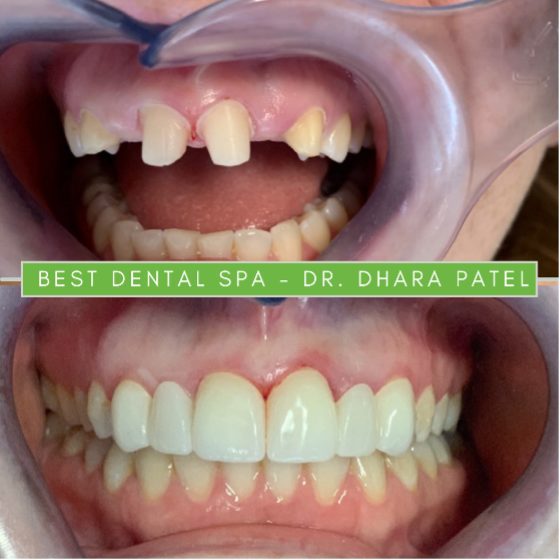Are you missing one or more teeth? Maybe you have consecutive missing teeth that create a tooth gap. Dental bridges can help fill in the gaps left by missing teeth while providing long-lasting support for oral health. Dr. Dhara Patel offers treatment with dental bridges in Hoffman Estates, IL.
Restoring missing teeth with a dental bridge can prevent shifting teeth and bone loss. Our office provides traditional dental bridges, implant-supported bridges, and Maryland bridges. We will help you find the best dental bridge for your restorative needs.

Problems Caused by Missing Teeth
Replacing missing teeth can improve your overall oral health and prevent further oral health problems. Some problems caused by gaps in your smile may include:
- Shifting teeth
- Misaligned bite
- Overcrowding
- Plaque buildup
- Receding gums
- Gum disease
- Tooth decay
Dental bridges offer multiple benefits to patients. This restoration can:
- Help support any remaining tooth structure
- Restore the ability to bite and chew evenly
- Prevent teeth from shifting
- Maintain a patient’s face shape
A dental bridge may be the right choice if you have a row of missing teeth. Receiving restorative care for lost permanent teeth can prevent further tooth loss and improve your confidence in your smile.
Restorative Treatment with Implant Dental Bridges in Hoffman Estates, IL
Dental bridges can be removable or fixed. Traditional bridges use natural teeth on either side of a missing tooth gap for support. Our dentist can cover these natural teeth with crowns to secure the bridge. While traditional bridges are cost-effective, other types of bridges can last longer.
We often recommend fixed implant-supported bridges. Fixed dental bridges provide more stability than removable dental bridges. Bonded or Maryland bridges are also options for patients missing a single tooth. A bonded bridge can also benefit younger patients with a missing permanent tooth.
Before treatment, Dr. Patel will examine the teeth and gums. She will then work with you to create a comprehensive, personalized restorative dental treatment plan for the dental bridge placement.
If you receive a traditional bridge, we will reshape the natural teeth adjacent to tooth gaps. This prepares the teeth for crowns and ensures they can properly support the bridge. Then, we take dental impressions of teeth, so your dental bridge is a custom fit.
Dental bridges usually consist of a metal framework covered by porcelain. The porcelain is color-matched to blend in with other natural teeth. When complete, Dr. Patel ensures that the dental bridge fits properly before attaching it with adhesive cement.
If you receive an implant-supported bridge, we will place the dental implants before the final bridge. It will take three to six months for the implants to heal. During this time, the implant posts fuse with the jawbone to become artificial tooth roots. Once the implants are fully healed, they serve as anchors for the bridge.
While receiving a fixed implant bridge can take more visits, the results are worth it. Dental implants ensure bridges last longer. The titanium implant posts also support the underlying jaw bone, unlike traditional bridges that lay on the gums.
Bonded Bridges: What are the Benefits?
A bonded bridge is a fixed permanent solution to replace your missing teeth. This can be the ideal treatment option for the growing young patient who is missing a tooth and cannot have a dental implant placement due to active skeletal growth. To fabricate a bonded bridge, our restorative dentist works with the dental lab to ensure that the bridge will fit esthetically and functionally in the correct position in your mouth.
A dental bonded bridge, or a Maryland bridge, is one solution dentists can use to replace a missing tooth. Treatment with a Maryland bridge takes less time and money than a conventional porcelain bridge or an implant. A bonded bridge can be an ideal solution to replace a missing tooth in the front of your mouth.
The bonded bridge is a porcelain false tooth with inside ceramic wings that bond to the adjacent healthy teeth. Bonded bridges need minimal or no preparations on the adjacent teeth. Bonding is an effective and proven dental treatment. It creates a long-term connection of the bonded bridge wing to the good adjacent teeth.
The Benefits of Bonded Dental Bridges in Hoffman Estates, IL
Due to the extremely high degree of biocompatibility, dentists can use bonded bridges in younger patients with missing teeth. Bonded bridges are preferable to a dental implant. There is strong evidence in dental literature that dental implants may not be appropriate for younger patients. Younger patients have incomplete skeletal development that is incompatible with implant treatment.
The research shows that properly constructed bonded bridges can last more than ten years. They last well beyond most of the skeletal development of the adolescent patient. Advantages of a bonded bridge include:
- Non-invasive
- Improved aesthetics
- Easy replacement when necessary
- Shorter treatment period
Special communication and coordination with the dentist are critical to ensure the long-term success of a bonded bridge. Our dentists have the training and expertise to provide bonded bridges to our patients.
Dental Bridge FAQs
Learn more about dental bridge treatment with answers to these common patient questions:
How is a bridge attached?
A dental bridge is usually attached by connecting the two closest teeth between the bridge. They aim to bridge the gap between teeth when one or more is missing. The bridge anchors to the two closest teeth to the gap. Bridges close the gap between teeth.
Are dental bridges permanent?
Bridges are a permanent treatment to close gaps between teeth. They typically last between 5- 10 years before needing to be replaced, but they can last longer depending on the material and placement in the jaw.
What material is best for dental bridges?
Combining patients’ strengths and aesthetic needs makes the best material choices. Porcelain is one of the most commonly chosen materials for bridges. We can also make ceramic, metal, gold, and acrylic bridges.

Before and after a dental bridge procedure.
Replace Your Missing Teeth Today
Receive treatment with dental bridges in Hoffman Estates and Schaumberg IL. Call Best Dental Spa for comfortable and comprehensive treatment at 847.660.6603. You can also schedule a dental exam online with Dr. Patel and her team. Dr. Patel and her staff will work with you through every step of the treatment process to ensure everything runs smoothly. At Best Dental Spa, we aim to provide a warm and friendly environment for all our patients.
